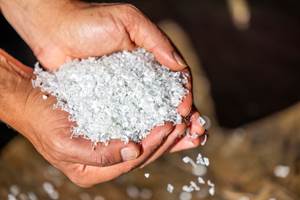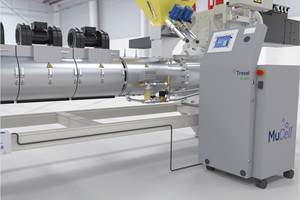The Fine Art Of Separation
If you need ground plastic waste separated from metal particles, or plastic flakes separated by color or density, Butler-MacDonald Inc. is up to the job.
If you need ground plastic waste separated from metal particles, or plastic flakes separated by color or density, Butler-MacDonald Inc. is up to the job. If your problem is to separate different plastics of the same color and density, this Indianapolis recycler can do that, too.
Very few recyclers can match such comprehensive automated separation capabilities. But it wasn’t always that way for Butler. In the late 1980s, Butler reclaimed metals for big utility companies. Along with scrapped switches, cables, and telephones came discarded central-office computers and other electronics. So the firm had to deal with more and more plastics.
Company founder J.D. Johnson was convinced there was value in those plastics, notably ABS. By 1990, Butler-MacDonald built its first equipment to recover plastics, a float/sink system that was rudimentary but automated. Automation distinguished it from the firm’s highly labor-intensive metal recovery. Butler had 150 employees and 450,000 sq ft of disassembly space in three locations.
Johnson had read about the use of hydrocyclones in the mining industry to separate tailings. So he bought some small cyclones and began to experiment with separating ABS from metal. The first small cyclones worked much better than the float/sink system, but the volume of telephone scrap was escalating. Butler would need more cyclones to keep up.
Hold the phone
At that point in 1993, AT&T offered Butler a contract to become its sole customer. AT&T wanted Butler to build a new plant in Mexico to use cheaper labor. The recycler, however, looked at its changing feed stream. “We could see that as more plastics came in, we would need more automation and less hand work,” recalls Butler president Scott Johnson, the founder’s son. “So we went back to AT&T and asked if they would listen to what we thought they needed.”
By 1995 Butler had built a big new automated plant based on hydrocyclones exclusively for AT&T. It could reclaim 50 million lb/yr of metals and 20 million lb/yr of ABS, PS, PC, PC/ABS, and PP. About 10 million lb/yr of ABS alone were recovered and sold by AT&T to compounders.
In 1998, Butler was still mainly reclaiming metal and was virtually captive to AT&T. Then AT&T split off its equipment manufacturing operations as Lucent Technologies. Butler’s recycling contract was assigned to Lucent, but Lucent, now divorced from AT&T’s phone installation ┤¾¤¾┤½├¢, didn’t generate much scrap. So Lucent and Butler agreed to end the contract.Plunging into plastics
Butler-MacDonald once again had to reinvent itself, switching from mostly metals to all-plastics reclaiming. It also changed from a one-account company that didn’t buy or sell anything to a toll plastics reclaimer with multiple sources and customers for its reclaimed plastics. New ┤¾¤¾┤½├¢ included disposable cameras.
Sourcing new suppliers and customers to replace AT&T wasn’t easy. Many customers for toll plastics remediation call only when they’ve had an accident, like blowing the wrong resin into a silo. Convincing first-time customers of Butler’s high-purity separation capabilities was also hard, Johnson says, because some processors had prior bad experiences with toll grinding and separation.
“Hydrocycloning is an art form,” Johnson asserts. “How well you get two densities to separate translates into the purity levels you get. We usually quote 99.9% purity, but there are lots of times when we achieve 100%.”
The company spent $750,000 to reconfigure its plant to separate a variety of polymers, both by color and density. Hydrocyclones would remain the mainstay of its new custom plastics separation ┤¾¤¾┤½├¢, but the plant had to be able to change polymer feed streams quickly. Where once Butler had a steady diet of telephones, it now rarely runs one feed stream for more than two or three days at a time.
Butler installed new size-reduction equipment, rare-earth magnets, ferrous and nonferrous metal detectors, color-separation equipment (from Satake USA Inc. in Houston), aspirators to remove paper and cardboard, and washing and rinsing equipment.
In February, Butler installed the first electrostatic separation equipment in the U.S. from Hamos GmbH in Germany (represented here by Progressive Design, Ft. Wayne, Ind.). This made it possible to separate plastics of the same color and density, such as PS and ABS or flexible and rigid PVC. Later this year, Butler will install a cryogenic size-reduction system to turn scrap PVC back into powder.
Related Content
Revalyu Breaks Ground on PET Recycling Facility in Georgia
Company expects new facility will be capable of chemically recycling 200 million pounds of post consumer PET per year.
Read MoreRecycling Machines Devolatilize and Decontaminate
NPE2024: Recycling for contaminated materials and challenging applications.
Read MoreFoam-Core Multilayer Blow Molding: How It’s Done
Learn here how to take advantage of new lightweighting and recycle utilization opportunities in consumer packaging, thanks to a collaboration of leaders in microcellular foaming and multilayer head design.
Read MoreTrinseo Starts Up PMMA Depolymerization Facility
The Italian facility’s chemical recycling process returns acrylics, including PMMA sheets, to monomer methyl methacrylate (MMA)
Read MoreRead Next
Making the Circular Economy a Reality
Driven by brand owner demands and new worldwide legislation, the entire supply chain is working toward the shift to circularity, with some evidence the circular economy has already begun.
Read MoreLead the Conversation, Change the Conversation
Coverage of single-use plastics can be both misleading and demoralizing. Here are 10 tips for changing the perception of the plastics industry at your company and in your community.
Read More











